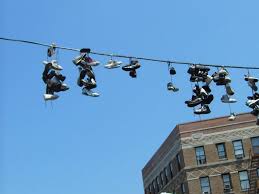Why Shoes End Up Hanging From Power Lines: A Closer Look at a Persistent Urban Mystery
If you’ve ever walked through a busy city block or a quiet neighborhood street and glanced up to find a pair of sneakers tied together and flung over a power line, you’re not alone. This strange yet widespread sight has puzzled people for decades.
Though it may appear random or meaningless, the act of tossing shoes onto utility wires carries a surprisingly wide range of interpretations shaped by local traditions, cultural beliefs, and community folklore.
Where the Practice May Have Begun
Pinpointing the true origin of shoe-tossing is nearly impossible, but several theories have stood the test of time. Some historians believe the ritual started with soldiers who threw their boots over wires to celebrate the end of their military service. Others argue that it became popular among certain street groups or gangs as a way to leave a visible mark in their territory. Over the years, stories evolved from neighborhood to neighborhood, creating a patchwork of explanations that continue to circulate today.

Symbolism and Cultural Meaning
Shoes hanging high above the street can represent anything from celebration to remembrance. In some communities, tossing footwear into the air is a symbolic gesture marking a life transition — moving to a new home, finishing school, or letting go of the past. In other areas, the shoes may serve as makeshift memorials for friends or loved ones who have passed away. Because the meaning changes depending on local culture, the practice has grown into a form of informal urban expression.
Popular Explanations Behind the Tradition
Different communities interpret the dangling shoes in their own ways. The most commonly mentioned theories include:
Youthful pranks and milestones: Teens may celebrate graduations, birthdays, or achievements by tossing old sneakers over a line.
Gang or territorial markers: Though widely rumored, evidence supporting this theory is inconsistent and varies significantly by region.
Drug activity signals: Urban legends claim shoes mark areas where drugs are bought or sold, but this idea is mostly anecdotal and not supported by official reports.
The Power of Urban Legends
The story of why shoes end up on power lines has been shaped largely by rumor and local lore. Depending on where you live, someone may insist the shoes mark a tragic event, signal criminal activity, or commemorate someone who has died. These stories often grow with retelling, adding an air of mystery that keeps the tradition alive.
Safety Risks Often Overlooked
What many people don’t realize is that shoes on power lines can be more dangerous than they seem. The added weight can strain or damage wires, disrupt electrical service, or create hazards for utility workers who must remove them. For this reason, cities routinely warn against the practice and encourage residents to report any incidents.
How Communities and Officials Handle It
Municipalities take varied approaches when dealing with shoe-tossing. Some cities quickly remove the shoes to prevent outages, while others treat them as minor nuisances unless they cause damage.
For example, utility crews in cities like Los Angeles conduct regular sweeps, especially after outages linked to objects hanging from lines. These situations can range from light-hearted pranks to intentional acts of vandalism, each requiring careful handling.
Public Reactions and Community Opinions
Not everyone sees the dangling shoes the same way. To some, the shoes add a quirky charm or artistic touch to an otherwise plain street. Others feel they’re an eyesore or a reminder of troubling neighborhood issues. In some communities, cleanup volunteers remove the shoes, while other neighborhoods embrace the mysterious tradition as part of their local identity.
Legal Considerations
Throwing shoes onto power lines isn’t just discouraged — in many places, it’s illegal. The act is often classified as vandalism or interference with public infrastructure, which can result in fines or other penalties. Utility companies work alongside law enforcement to investigate cases that create safety hazards or damage property.
Preventing Future Incidents
To discourage the practice, cities often work with schools, youth programs, and neighborhood groups to educate residents about the risks. Awareness campaigns emphasize that while the tradition may seem harmless or playful, the consequences can be serious.
Conclusion
Shoes swinging high above a street represent far more than discarded footwear. They reflect layers of community history, cultural symbolism, and shared storytelling that vary from one neighborhood to the next.
Whether tossed as a prank, a celebration, or a quiet tribute, they reveal how people use public spaces to express themselves — sometimes mysteriously, sometimes boldly. By understanding the many interpretations behind this phenomenon, we gain insight into the creative, complex, and often unexpected ways urban culture takes shape.
